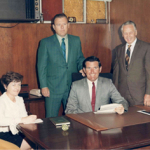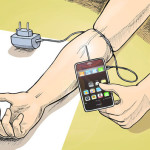 Over the last few weeks, the attack on diversity initiatives has grown increasingly absurd. In the fervor to scrub race from U.S. government web pages, Jackie Robinson, black soldiers who fought in the Civil War and the Navajo Code Breakers mistakenly disappeared. The black head of the Joint Chiefs got canned, and the white female heads of the Navy and Coast Guard suffered similar fates. The message dovetailed off the words of Darren Beattie, the recently appointed undersecretary for public diplomacy who last year wrote: “Competent white men must be in charge if you want things to work.”
Over the last few weeks, the attack on diversity initiatives has grown increasingly absurd. In the fervor to scrub race from U.S. government web pages, Jackie Robinson, black soldiers who fought in the Civil War and the Navajo Code Breakers mistakenly disappeared. The black head of the Joint Chiefs got canned, and the white female heads of the Navy and Coast Guard suffered similar fates. The message dovetailed off the words of Darren Beattie, the recently appointed undersecretary for public diplomacy who last year wrote: “Competent white men must be in charge if you want things to work.”
Oddly, I’ve been saying the exact opposite for years, based on actual experience. The leadership of our company is a extraordinary mix of brown males and females, immigrants, and white men and women. I know the place works because of that. We promote the person best suited to the job, who has the blend of technical skills and personality to handle the challenges they’ll face, while showing promise to move up to the next level.
Take our scheduling director. She’s first generation Laotian, started as the receptionist, moved into customer service and then took over scheduling. Somehow, and I don’t know exactly how, she keeps a 200,000 square foot factory running 24/7, 362 days with minimal downtime while handling one customer crisis after another. The white men who’ve tried the job want nothing to do with it. So what ? I have a proven leader who works around the clock and gets stuff done. That she’s a Hmong woman doesn’t enter into the equation.
Or does it? Is it possible that culture shapes the person? Immigrant and first gen women seem driven in a way their co-workers aren’t, including me. My head spins with what they get done in a day, including taking on and unraveling incredibly complex issues. There’s just a get-to-it spirit that drives the best of them, in the way us second generation types rarely muster. My first gen Director of Human Resources, for example, took the almost unheard of step for an HR executive of earning her MBA (while caring for a newborn, I must add). Growing up without often proves a great motivator. I can point to my own first gen father — a white male — as a great illustration. It’s just that we don’t have many European immigrants anymore. These days most are brown. Either way, I’m lucky to have them.
Research backs up my intuition. Back in 2019 the consultancy McKinsey & Co. found that companies in the top quartile for gender diversity boasted profits 25% higher than the laggards in the bottom quarter. Ethnic diversity proved even more decisive, with the gap widening to 36%. The Harvard Business Review attributes such success to the way diverse teams challenge each other to think more broadly thanks to differing life experiences. They tend to make more factual decisions because preconceptions are more likely to get challenged, again thanks to different perspectives.
I’m not saying DEI programs didn’t get a little silly in some cases, if not worse. The problem comes when company’s build quotas and limit searches, instead of creating a culture where any gender or color can thrive. There’s no doubt we owe a debt to the ground breakers, people like the baseball great Jackie Robinson, who broke the color barrier enduring racist chants and insults from players, while building one of the most impressive resumes in the sport. His success showed what we had missed not including blacks at the highest levels. So why even consider taking down his web page?
The Administration itself undercuts its own arguments. Women dot its upper echelons, including chief of staff to the president, head of the Department of Homeland Security, and Attorney General. Why are they not DEI hires but Vice President Kamela Harris was, according to then candidate Trump? Why don’t black soldiers in the Civil War, who faced execution or slavery if captured, deserve mention for the ruthless bravery they exhibited?
I’m not sure where the anger about diversity comes from. I suspect, as Mr. Beattie suggests, it’s a backlash from white men, who feel passed over for positions they think they deserve. Whether they do or not. It ain’t easy to give up first position. I’ve seen it in my own company, where white males are more critical of brown and female department heads than they are of their counterparts. It isn’t uncommon for unpopular decisions to get pushed on them, and then their answers roundly criticized, another little fact noticed by the Financial Times. Still, we come together, put stuff behind us and make our company hum.
Ultimately I worry that the vilification of DEI will undercut the legitimacy of nontraditional leaders. I’m concerned the hostile environment will grow so strong that they’ll end up stepping down or taking demotions. That would be a mistake, as the research shows. Think of what we lose. After all, who will have the guts to steal home base?*
*Picture of Jackie Robinson famously stealing home in the 1955 World Series, a feat he accomplished 19 times in his career, which prior to his inclusion rarely happened.







 I remember exactly where I was when the insurer American International Group (AIG) collapsed in 2008–standing in Intercontinental Airport in Houston, waiting for a flight to Mexico. The news sent a shiver through me. I knew at that moment the long expansion of our economy had ended. I also concluded in an instant that we would not purchase the $4 million printing press that I had been on the verge of buying. Time to preserve cash, I figured. Get ready for reduced demand. Hunker down.
I remember exactly where I was when the insurer American International Group (AIG) collapsed in 2008–standing in Intercontinental Airport in Houston, waiting for a flight to Mexico. The news sent a shiver through me. I knew at that moment the long expansion of our economy had ended. I also concluded in an instant that we would not purchase the $4 million printing press that I had been on the verge of buying. Time to preserve cash, I figured. Get ready for reduced demand. Hunker down.